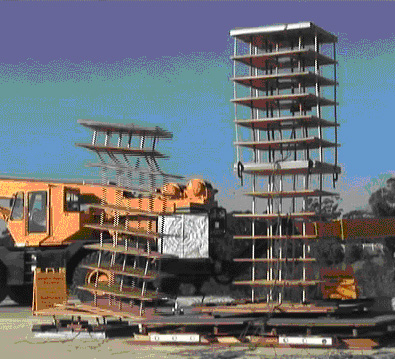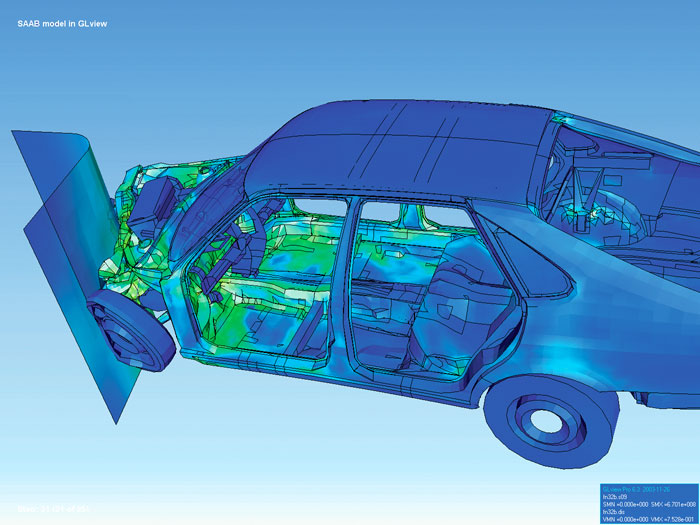|
Sarma Method
The Sarma method is a method used primarily to assess the stability of soil slopes under seismic conditions. Using appropriate assumptions the method can also be employed for static slope stability analysis. It was proposed by Sarada K. Sarma in the early 1970s as an improvement over the other conventional methods of analysis which had adopted numerous simplifying assumptions. History Sarma worked in the area of seismic analysis of earth dams under Ambraseys at Imperial College for his doctoral studies in the mid 1960s. The methods for seismic analysis of dams available at that time were based on the Limit Equilibrium approach and were restricted to planar or circular failures surfaces adopting several assumptions regarding force and moment equilibrium (usually satisfying one of the two) and about the magnitude of the forces (such as interslice forces being equal to zero). Sarma looked into the various available methods of analysis and developed a new method for analysis in sei ... [...More Info...] [...Related Items...] OR: [Wikipedia] [Google] [Baidu] |
Earthquake
An earthquake (also known as a quake, tremor or temblor) is the shaking of the surface of the Earth resulting from a sudden release of energy in the Earth's lithosphere that creates seismic waves. Earthquakes can range in intensity, from those that are so weak that they cannot be felt, to those violent enough to propel objects and people into the air, damage critical infrastructure, and wreak destruction across entire cities. The seismic activity of an area is the frequency, type, and size of earthquakes experienced over a particular time period. The seismicity at a particular location in the Earth is the average rate of seismic energy release per unit volume. The word ''tremor'' is also used for Episodic tremor and slip, non-earthquake seismic rumbling. At the Earth's surface, earthquakes manifest themselves by shaking and displacing or disrupting the ground. When the epicenter of a large earthquake is located offshore, the seabed may be displaced sufficiently to cause ... [...More Info...] [...Related Items...] OR: [Wikipedia] [Google] [Baidu] |
Earthquake Engineering
Earthquake engineering is an interdisciplinary branch of engineering that designs and analyzes structures, such as buildings and bridges, with earthquakes in mind. Its overall goal is to make such structures more resistant to earthquakes. An earthquake (or seismic) engineer aims to construct structures that will not be damaged in minor shaking and will avoid serious damage or collapse in a major earthquake. Earthquake engineering is the scientific field concerned with protecting society, the natural environment, and the man-made environment from earthquakes by limiting the seismic risk to socio-economically acceptable levels. Traditionally, it has been narrowly defined as the study of the behavior of structures and geo-structures subject to seismic loading; it is considered as a subset of structural engineering, geotechnical engineering, mechanical engineering, chemical engineering, applied physics, etc. However, the tremendous costs experienced in recent earthquakes have led to an ... [...More Info...] [...Related Items...] OR: [Wikipedia] [Google] [Baidu] |
Boundary Element Method
The boundary element method (BEM) is a numerical computational method of solving linear partial differential equations which have been formulated as integral equations (i.e. in ''boundary integral'' form), including fluid mechanics, acoustics, electromagnetics (where the technique is known as method of moments or abbreviated as MoM), fracture mechanics, and contact mechanics. Mathematical basis The integral equation may be regarded as an exact solution of the governing partial differential equation. The boundary element method attempts to use the given boundary conditions to fit boundary values into the integral equation, rather than values throughout the space defined by a partial differential equation. Once this is done, in the post-processing stage, the integral equation can then be used again to calculate numerically the solution directly at any desired point in the interior of the solution domain. BEM is applicable to problems for which Green's functions can be calculated ... [...More Info...] [...Related Items...] OR: [Wikipedia] [Google] [Baidu] |
Finite Difference Method
In numerical analysis, finite-difference methods (FDM) are a class of numerical techniques for solving differential equations by approximating derivatives with finite differences. Both the spatial domain and time interval (if applicable) are discretized, or broken into a finite number of steps, and the value of the solution at these discrete points is approximated by solving algebraic equations containing finite differences and values from nearby points. Finite difference methods convert ordinary differential equations (ODE) or partial differential equations (PDE), which may be nonlinear, into a system of linear equations that can be solved by matrix algebra techniques. Modern computers can perform these linear algebra computations efficiently which, along with their relative ease of implementation, has led to the widespread use of FDM in modern numerical analysis. Today, FDM are one of the most common approaches to the numerical solution of PDE, along with finite element metho ... [...More Info...] [...Related Items...] OR: [Wikipedia] [Google] [Baidu] |
Finite Element Method
The finite element method (FEM) is a popular method for numerically solving differential equations arising in engineering and mathematical modeling. Typical problem areas of interest include the traditional fields of structural analysis, heat transfer, fluid flow, mass transport, and electromagnetic potential. The FEM is a general numerical method for solving partial differential equations in two or three space variables (i.e., some boundary value problems). To solve a problem, the FEM subdivides a large system into smaller, simpler parts that are called finite elements. This is achieved by a particular space discretization in the space dimensions, which is implemented by the construction of a mesh of the object: the numerical domain for the solution, which has a finite number of points. The finite element method formulation of a boundary value problem finally results in a system of algebraic equations. The method approximates the unknown function over the domain. The ... [...More Info...] [...Related Items...] OR: [Wikipedia] [Google] [Baidu] |
Numerical Analysis
Numerical analysis is the study of algorithms that use numerical approximation (as opposed to symbolic manipulations) for the problems of mathematical analysis (as distinguished from discrete mathematics). It is the study of numerical methods that attempt at finding approximate solutions of problems rather than the exact ones. Numerical analysis finds application in all fields of engineering and the physical sciences, and in the 21st century also the life and social sciences, medicine, business and even the arts. Current growth in computing power has enabled the use of more complex numerical analysis, providing detailed and realistic mathematical models in science and engineering. Examples of numerical analysis include: ordinary differential equations as found in celestial mechanics (predicting the motions of planets, stars and galaxies), numerical linear algebra in data analysis, and stochastic differential equations and Markov chains for simulating living cells in medicine an ... [...More Info...] [...Related Items...] OR: [Wikipedia] [Google] [Baidu] |
Rankine Lecture
The Rankine lecture is an annual lecture organised by the British Geotechnical Association named after William John Macquorn Rankine, an early contributor to the theory of soil mechanics. This should not be confused with the biennial BGA Géotechnique Lecture. The Rankine Lecture is held in March each year. In even-numbered years, the lecturer is from the UK. In odd-numbered years, the lecturer is from outside the UK. Each lecture is usually published in Géotechnique. List of Rankine Lecturers See also * Named lectures * Géotechnique Lecture The Géotechnique lecture is an biennial lecture on the topic of soil mechanics, organised by the British Geotechnical Association named after its major scientific journal Géotechnique. This should not be confused with the annual BGA Rankine L ... External links ICE Virtual Library - The Rankine LectureBritish Geotechnical Association - List of Rankine LecturersBritish Geotechnical Association References {{Rankine Lecturers ... [...More Info...] [...Related Items...] OR: [Wikipedia] [Google] [Baidu] |
Newmark's Sliding Block
The Newmark's sliding block analysis method is an engineering that calculates permanent displacements of soil slopes (also embankments and dams) during seismic loading. Newmark analysis does not calculate actual displacement, but rather is an index value that can be used to provide an indication of the structures likelihood of failure during a seismic event. It is also simply called Newmark's analysis or Sliding block method of slope stability analysis. History The method is an extension of the Newmark's direct integration method originally proposed by Nathan M. Newmark in 1943. It was applied to the sliding block problem in a lecture delivered by him in 1965 in the British Geotechnical Association's 5th Rankine Lecture in London and published later in the Association's scientific journal ''Geotechnique''. The extension owes a great deal to Nicholas Ambraseys whose doctoral thesis on the seismic stability of earth dams at Imperial College London in 1958 formed the basis of the meth ... [...More Info...] [...Related Items...] OR: [Wikipedia] [Google] [Baidu] |
Slope Stability
Slope stability analysis is a static or dynamic, analytical or empirical method to evaluate the stability of earth and rock-fill dams, embankments, excavated slopes, and natural slopes in soil and rock. Slope stability refers to the condition of inclined soil or rock slopes to withstand or undergo movement. The stability condition of slopes is a subject of study and research in soil mechanics, geotechnical engineering and engineering geology. Analyses are generally aimed at understanding the causes of an occurred slope failure, or the factors that can potentially trigger a slope movement, resulting in a landslide, as well as at preventing the initiation of such movement, slowing it down or arresting it through mitigation countermeasures. The stability of a slope is essentially controlled by the ratio between the available shear strength and the acting shear stress, which can be expressed in terms of a safety factor if these quantities are integrated over a potential (or actual) s ... [...More Info...] [...Related Items...] OR: [Wikipedia] [Google] [Baidu] |
Finite Element Limit Analysis
A finite element limit analysis (FELA) uses optimisation techniques to directly compute the upper or lower bound plastic collapse load (or limit load) for a mechanical system rather than time stepping to a collapse load, as might be undertaken with conventional non-linear finite element techniques. The problem may be formulated in either a kinematic or equilibrium form.Sloan, S. (1988). Lower bound limit analysis using finite elements and linear programming. Int. J. Num. Anal. Meth. in Geomech. 12(4), 61–77. The technique has been used most significantly in the field of soil mechanics for the determination of collapse loads for geotechnical problems (e.g. slope stability analysis). An alternative technique which may be used to undertake similar direct plastic collapse computations using optimization is Discontinuity layout optimization. Software for finite element limit analysis OptumG2(2014-) General purpose software for 2D geotechnical applications. OptumG3(2017-) General purp ... [...More Info...] [...Related Items...] OR: [Wikipedia] [Google] [Baidu] |
Slope Stability Analysis
Slope stability analysis is a static or dynamic, analytical or empirical method to evaluate the stability of earth and rock-fill dams, embankments, excavated slopes, and natural slopes in soil and rock. Slope stability refers to the condition of inclined soil or rock slopes to withstand or undergo movement. The stability condition of slopes is a subject of study and research in soil mechanics, geotechnical engineering and engineering geology. Analyses are generally aimed at understanding the causes of an occurred slope failure, or the factors that can potentially trigger a slope movement, resulting in a landslide, as well as at preventing the initiation of such movement, slowing it down or arresting it through mitigation countermeasures. The stability of a slope is essentially controlled by the ratio between the available shear strength and the acting shear stress, which can be expressed in terms of a safety factor if these quantities are integrated over a potential (or actual) s ... [...More Info...] [...Related Items...] OR: [Wikipedia] [Google] [Baidu] |



.png)